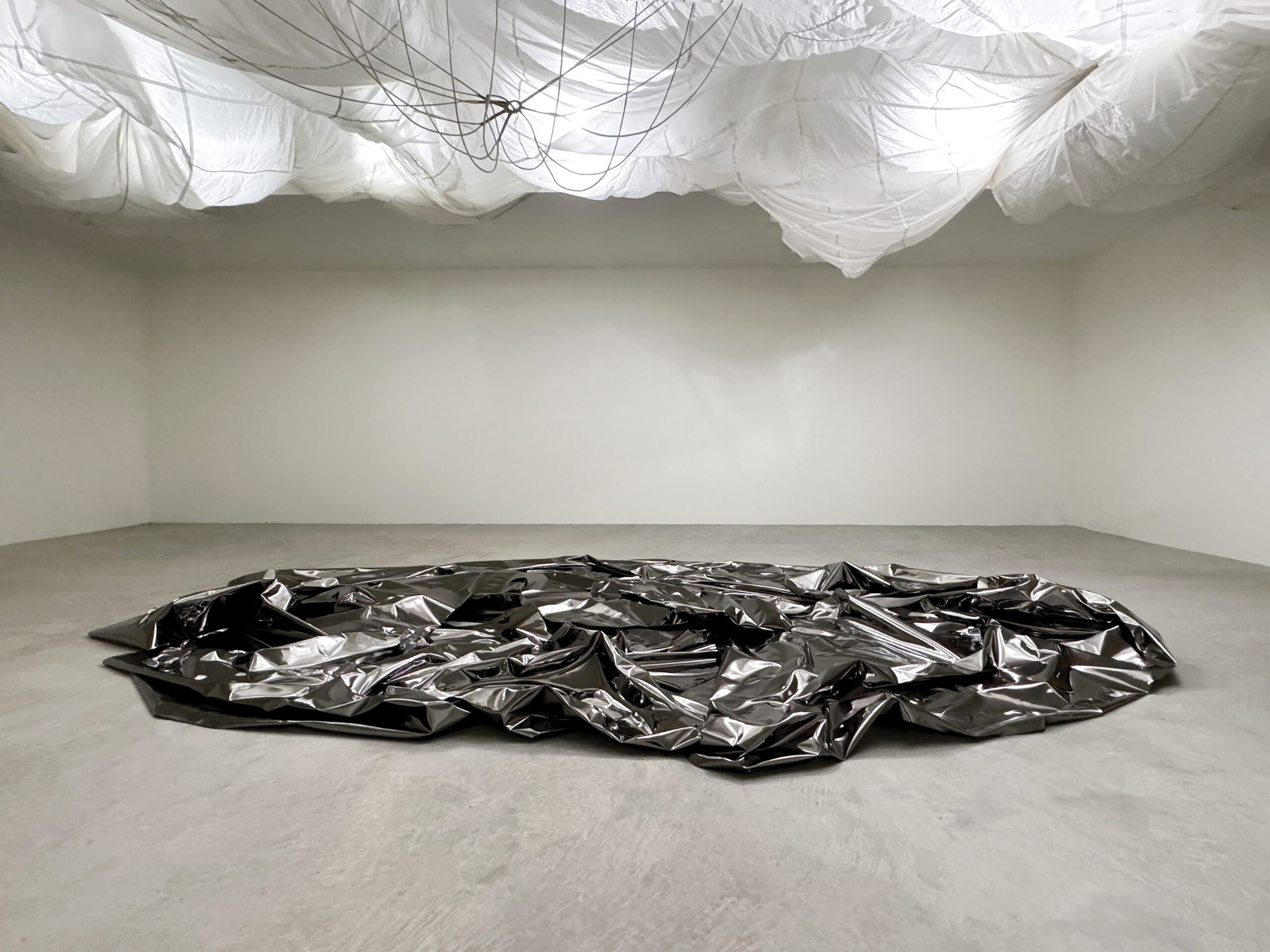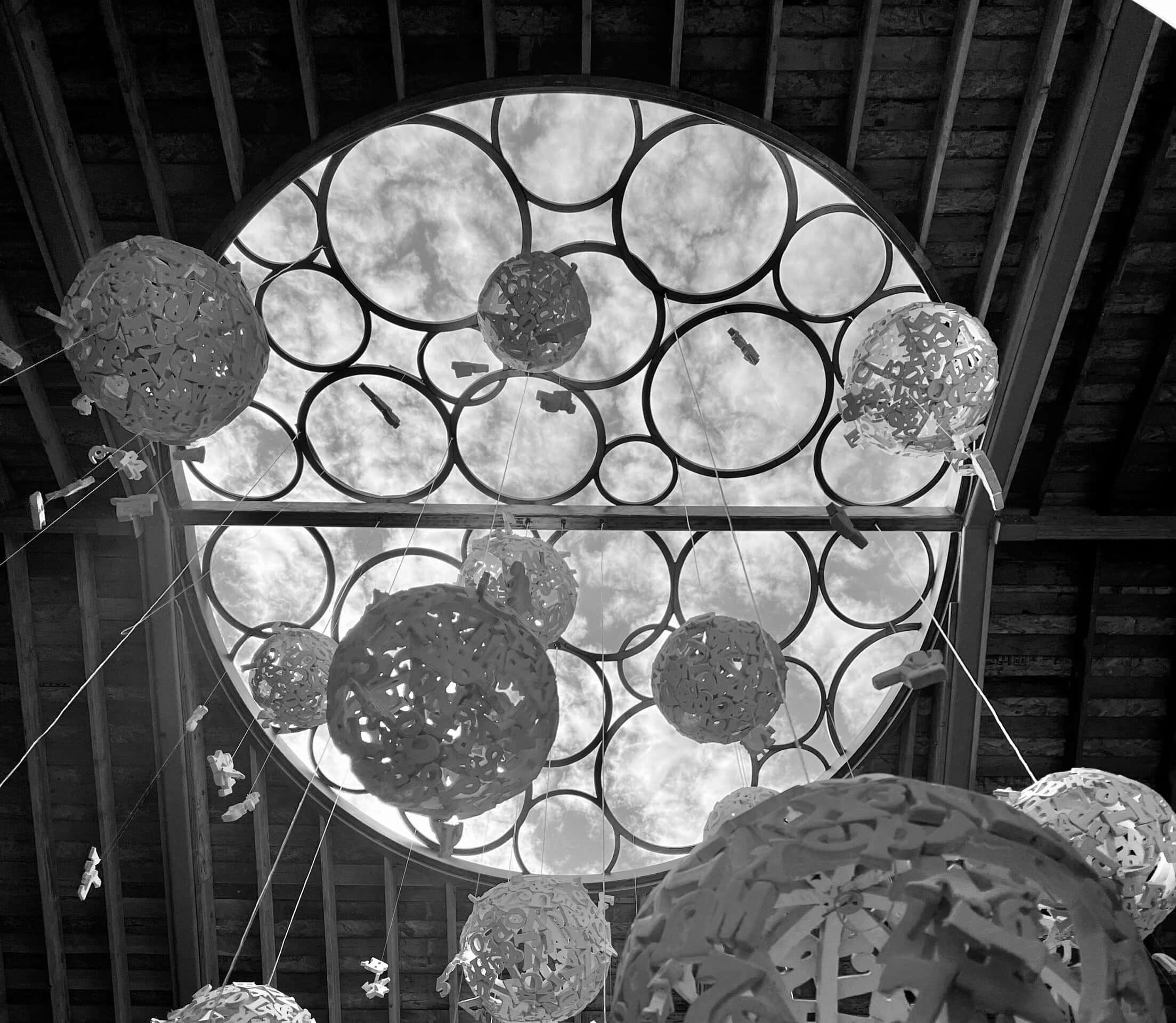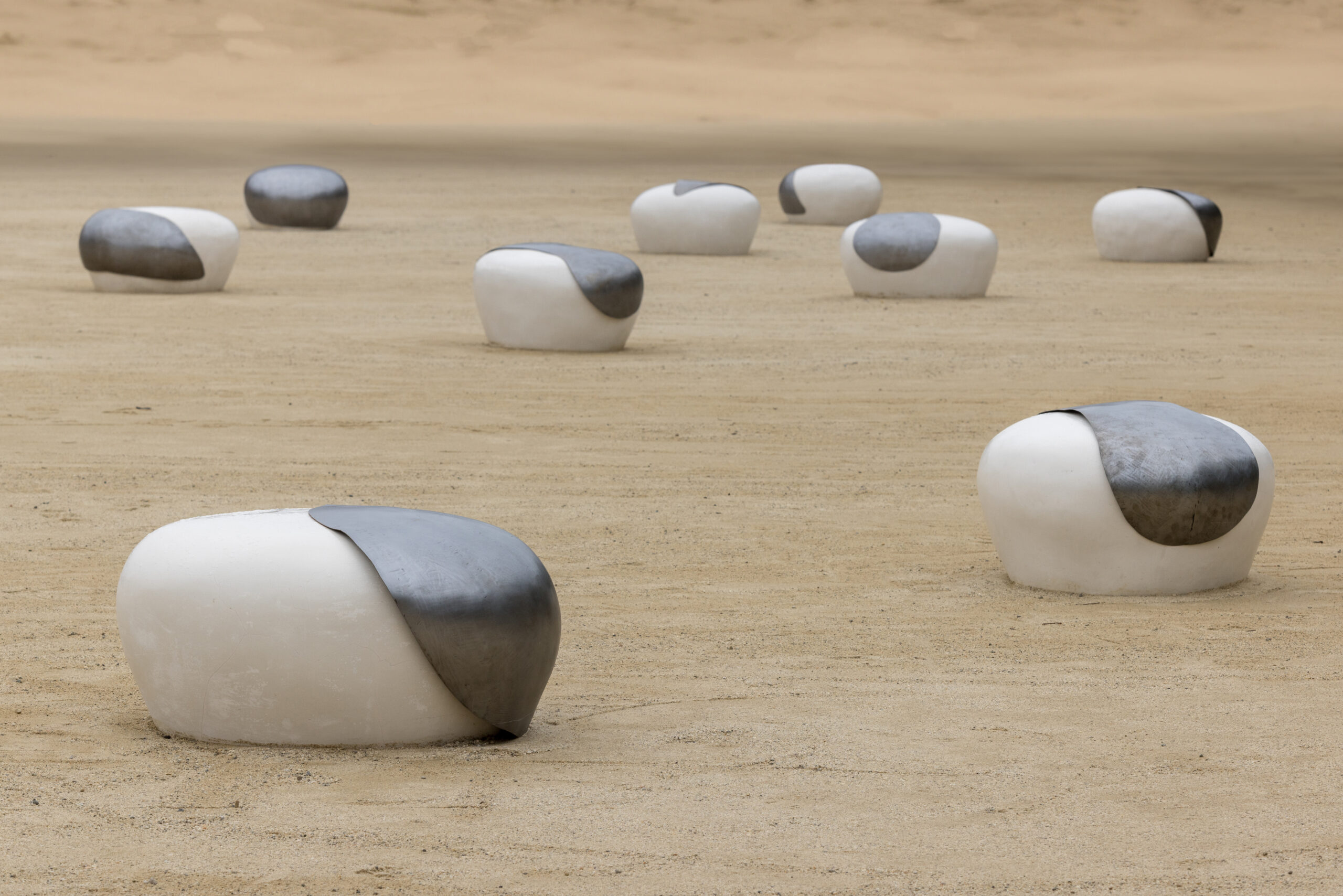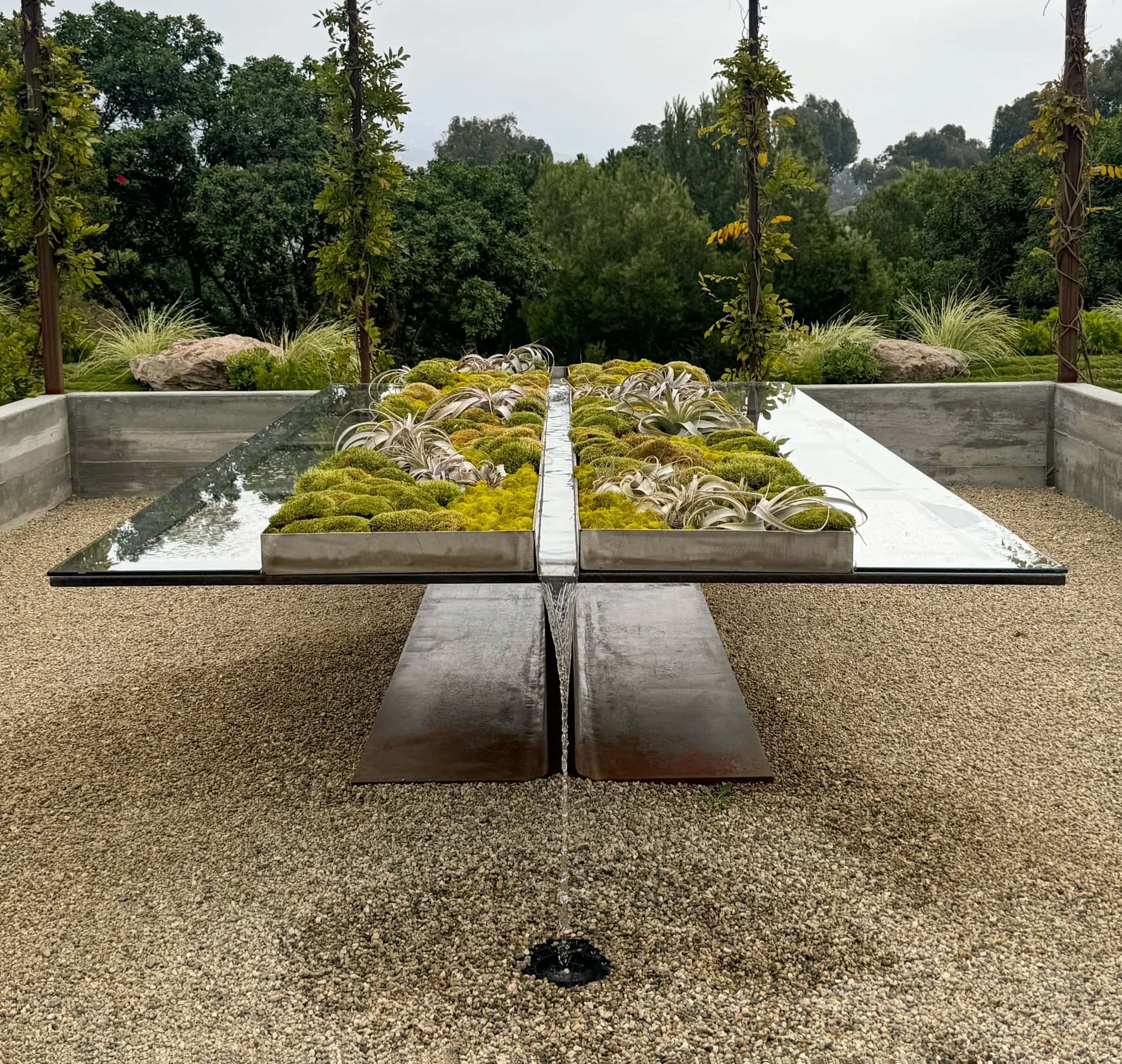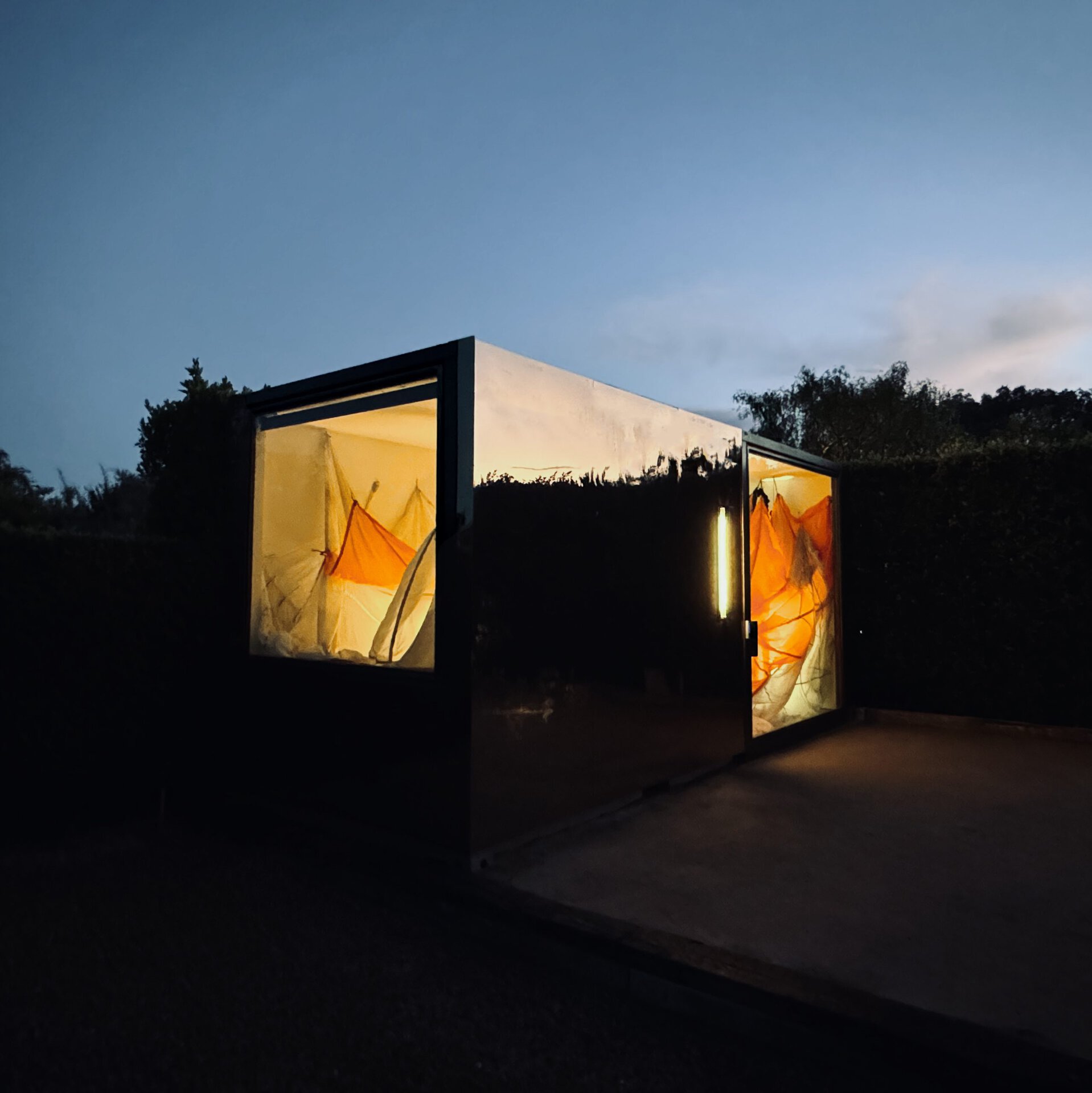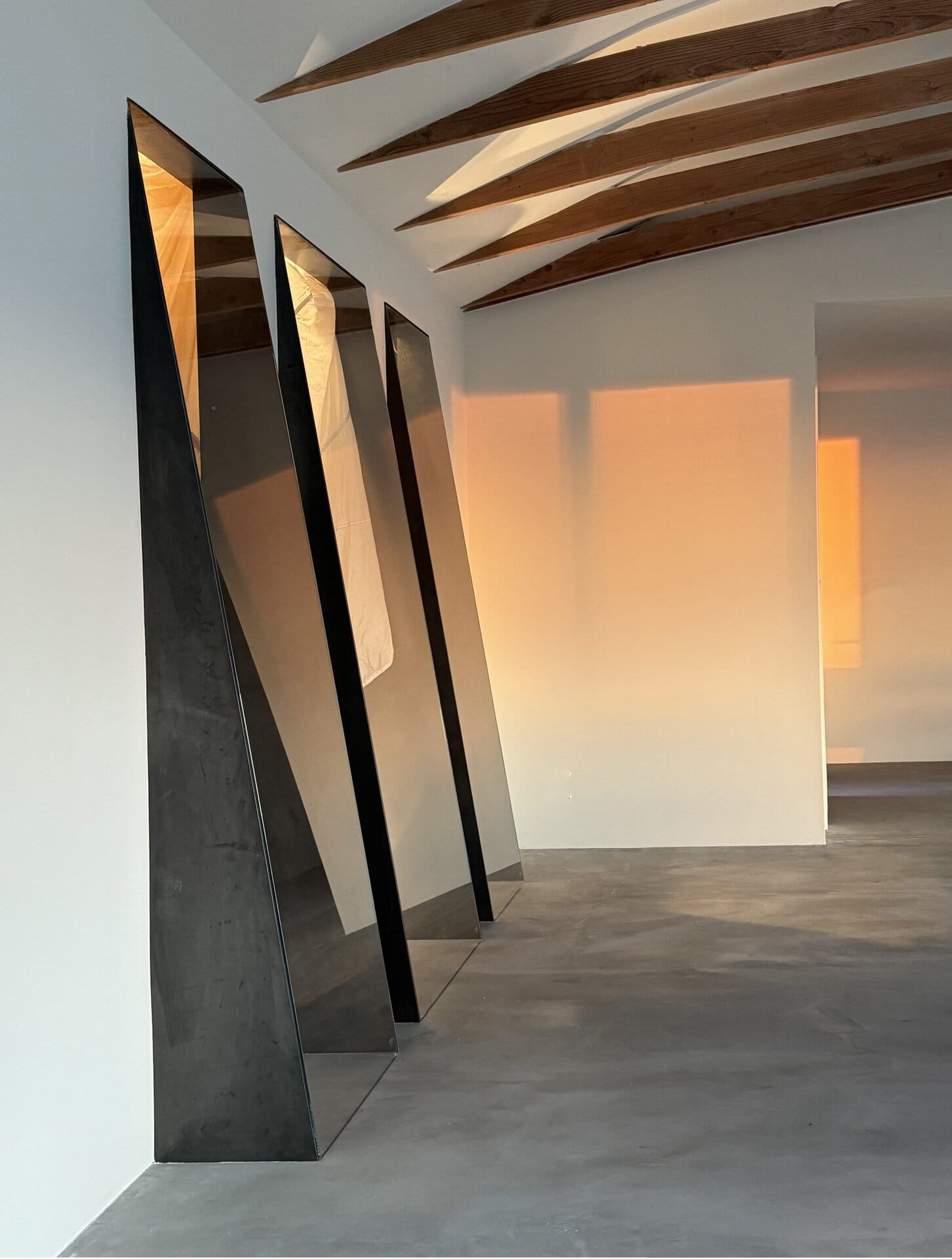Drift
The Drift installation showcases the use of D’Annibale’s signature material, the vintage parachute, in the most multifaceted way. The artwork fills an entire room, and the parachute is woven into its ceiling. D’Annibale carefully layers over the silk to create an elaborate, dynamic ‘relief’. Its intricate surface is enhanced with light and air blowing from behind. On the floor, there is a near mirror-image sculpture made of metallic material. On the walls, a video projection of the artist sculpting the parachute unfolds continuously. D’Annibale brings together an array of techniques and textures to envelope the viewer with a novel spatial and sensory experience. Light and heavy, in motion or still, loose or attached, the parachute adopts different forms, becoming the main character of this immersive performance. The rectangular shape of the room disappears under the sculptural interventions and moving image. Here, D’Annibale lets us inside an intimate and comforting environment, whereas in the Vaults and Liminals series, reversely, we observe it from outside. Phenomenological inquiry is at the core of D’Annibale’s practice as she explores the limits of context in relation to an object.
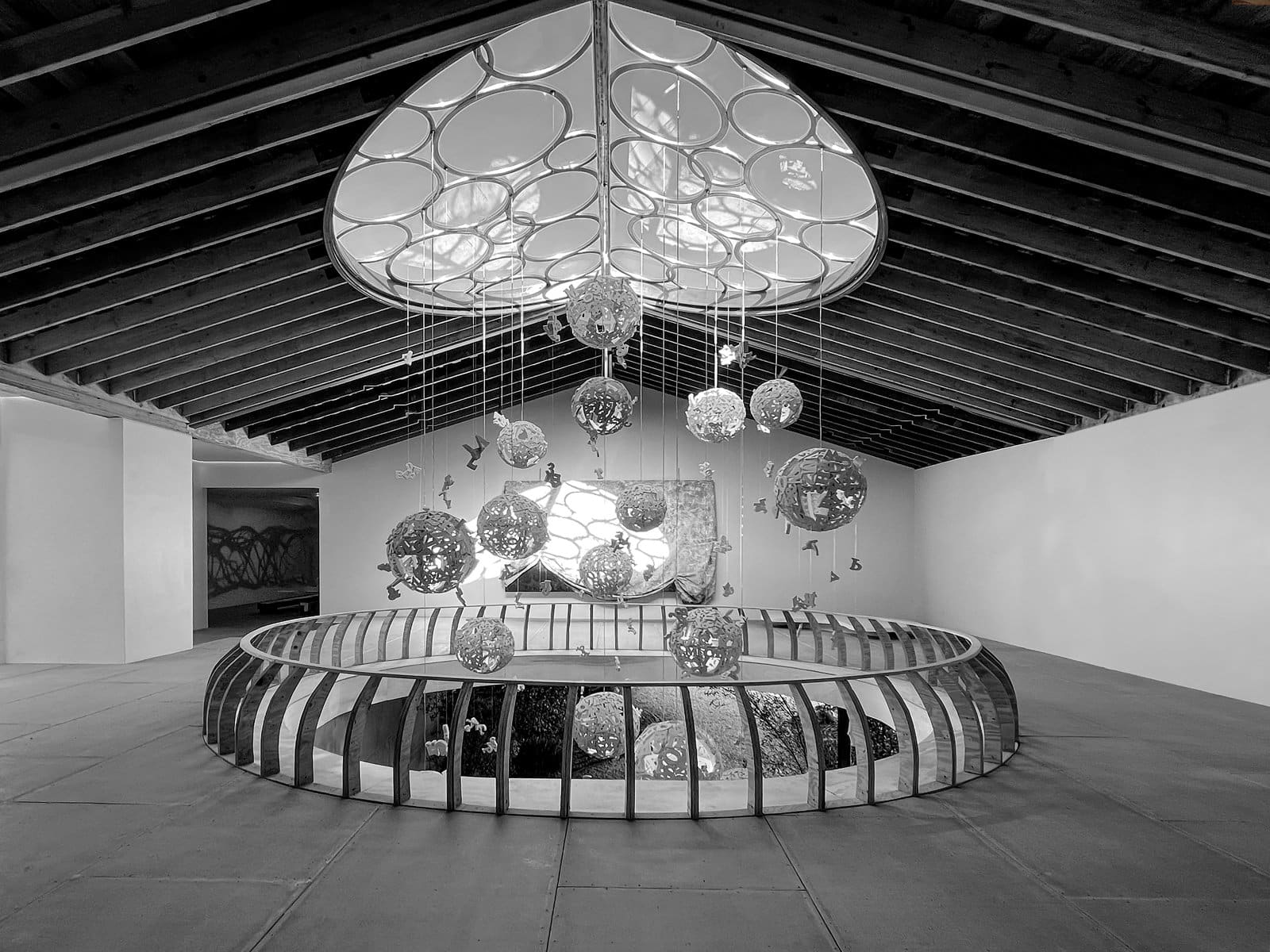
Amalgamation & Oculus
For D’Annibale, space is an integral component of an art piece. When working on sites especially, her handling of space becomes visibly sculptural. There is no void but rather ‘indivisible clay’, and the shape, placement and size of all components of the overarching composition are carefully considered. At the epicenter of the Dume 1 site is the preexisting architectural structure, resembling a ranch house. D’Annibale intentionally evokes familiar prototypical forms to enhance the impact on the viewer as she treats them as art objects. A monumental, four-ton steel and glass Oculus breaks the roof’s rig, letting the natural color and light indoors. Its radius determines the shape of Amalgamation, an intangible column made of the negative space which penetrates through the ground and lower levels. D’Annibale comfortably operates at the intersection of mediums and concepts, oscillating between sculpture and intervention. The Amalgamation is effectively a voluminous empty space which springs out unexpectedly upon entering the prototypical house and thus forever changes our experience of the site.
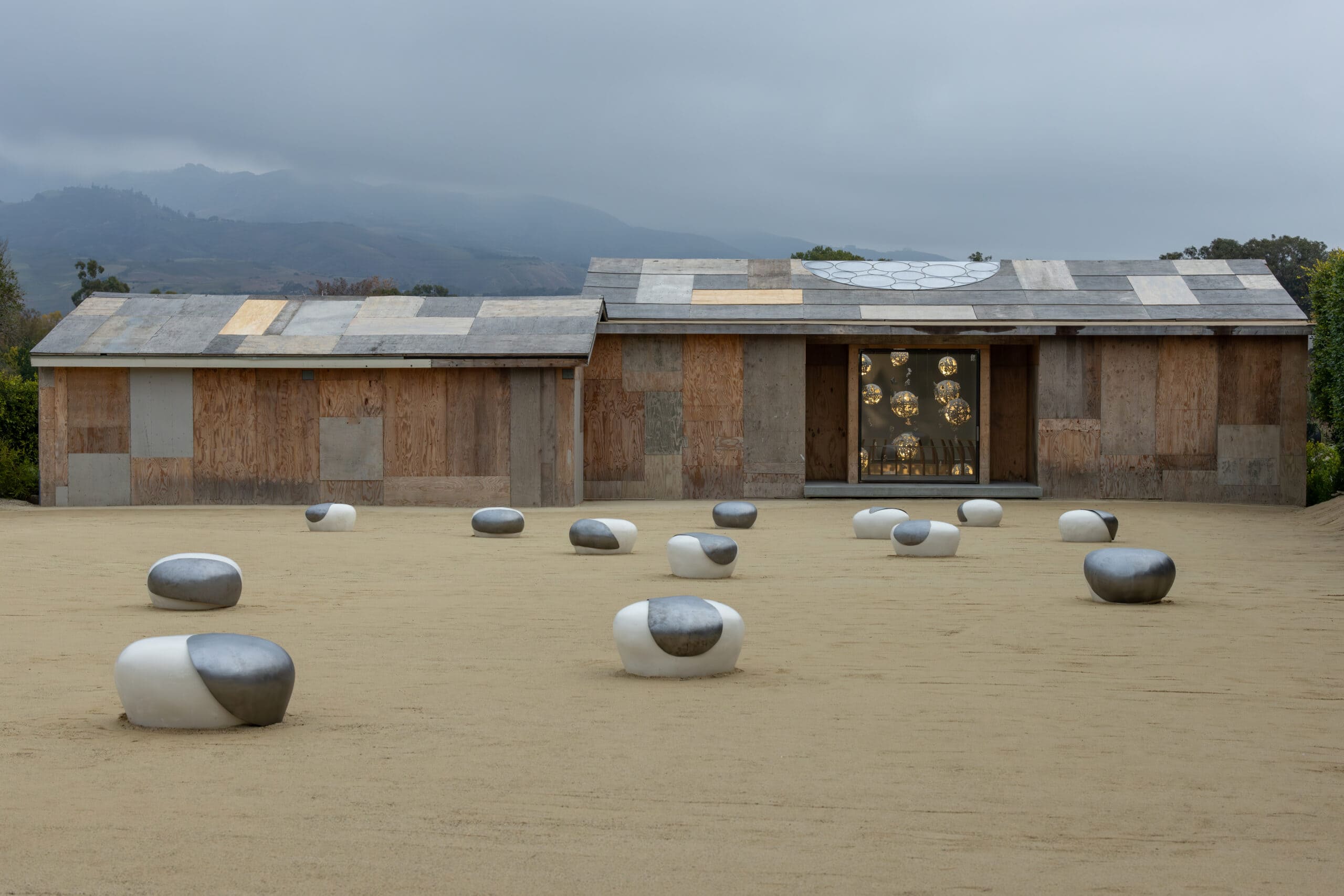
Dots
The Dots are a series of sculptures presented as individual pieces or as an installation. They take a prime, rounded organic shape, resembling an enlarged drop of water. Intentionally hand-made, they are elegantly molded and polished yet imperfect, like in nature. The granite base is partially covered with either metal or colored encaustic wax. The interplay between the natural and the industrial is apparent in D’Annibale’s choice of materials, forms and setting. Upon entering the Dume 1 site, we are struck by the combined vastness of its one-acre meter spread, the landscape behind it, and the sand field in front. Peppered carefully across this evocative ‘domestic desert’, the Constellation of 16 Dots Harmoniously Arranged installation effortlessly fits into the natural terrain, yet its appearance is intentional and arbitrary. D’Annibale explores the notion of minimal – man-made yet nature-inspired – intervention to alter the spatial experience. Relying on her poetic intuition and understanding of construction combined, she makes her mark visible but never too disruptive, creating a nature-like sense of tranquility and harmony.
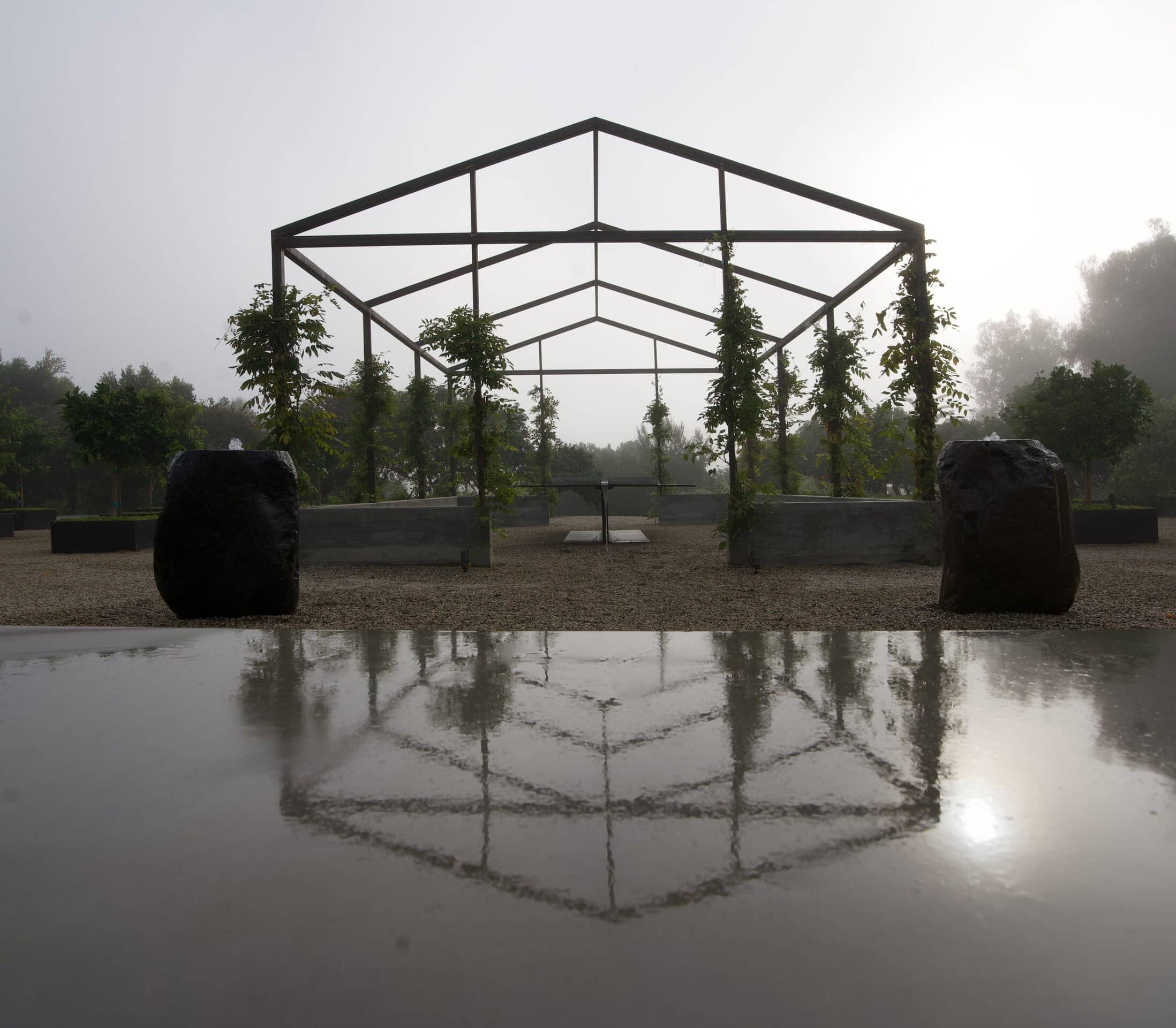
Cloud House & The Island
Cloud House is a site-specific installation pertaining to the 2.2 Wildlife project. Known for her phenomenological approach, D’Annibale often uses familiar forms and structures to provoke deeper inquiry. In Cloud House, she explores the concept of home and the sublime through a minimal steel skeleton of a house nestled among orchard trees, containing a glass and steel ‘table-shape’ form, The Island. Three industrial materials—glass, steel, and concrete—form the foundation of the work, but they come alive as D’Annibale introduces plants to grow over the prototypical table and beams. The open sky and water running through The Island complete the installation, merging the structure with its natural surroundings. D’Annibale transforms a familiar domestic form into a sculptural exploration of the fluidity of space and the impermanence of structures. By capturing negative space, she highlights the invisible aspects of architecture—its history, purpose, and role in shaping human lives. Cloud House challenges the boundaries between art, space, and experience, urging viewers to engage more deeply with the environments they often overlook.
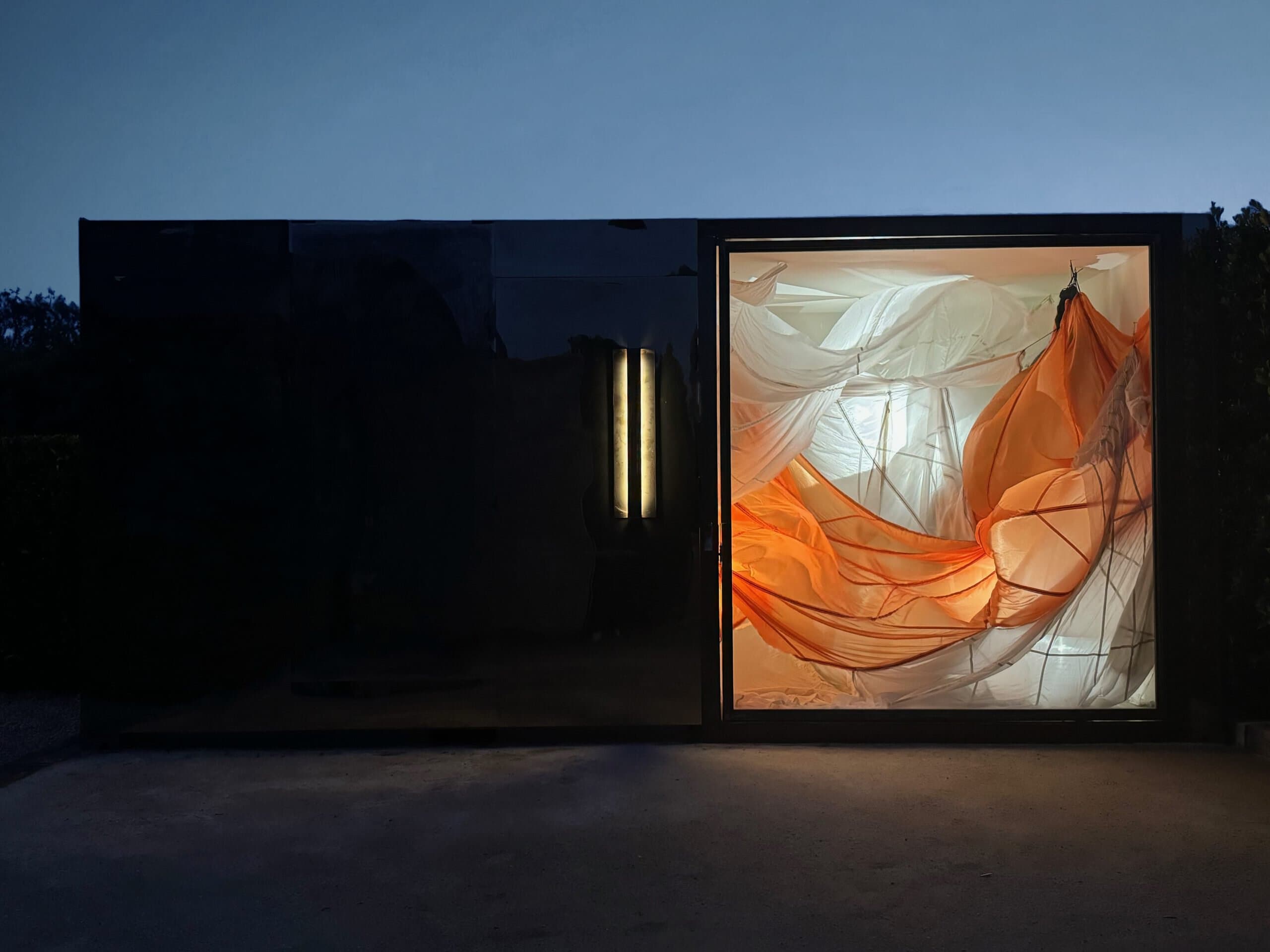
Vaults
The form and notion of a container run through D’Annibale’s practice as she consistently challenges the subject-object, inside-outside dialectics. D’Annibale intentionally repurposes a common and highly functional object, abstracting its form into a prototypical structure which carries ideas and aesthetic qualities. The container is covered with colored glass, thus becoming an independent sculpture which connects with nature through reflection on its surface. Inside the Vaults are vintage parachutes arranged in a web-like composition, set in motion by air and lighting.
Areas of see-through glass allow us to observe this dynamic sculpture, somewhat trapped inside. The act of covering and revealing is symbolic of D’Annibale’s search for truth, prime emotions and forms. Tension is apparent between the insides, densely layered with soft silk, and the rigid, rectangular shape of the steel container. The architectural and reasonable go hand in hand with the soft and intuitive.
Liminals
The Liminals stem from D’Annibale’s fascination with the boundaries and conditions of different mediums. The series is conceived as a sculptural intervention into an architectural structure in a way that resonates with the overarching design. A triptych of semi-pillars extends from the wall at an angle; their sides are metal, and their fronts are glass. The wall behind is hollowed out to home parachutes set in constant motion with air. Light and air shape this ephemeral sculpture as it can be observed inside the cabinet-like structure of each pillar. Typical of D’Annibale is the contrast between the sleek industrial materials and soft, vintage silk of the parachute, the warm light and dark, deep background. The work occupies the metaphoric ‘liminal space’ between different disciplines, thus encompassing different qualities. It is as if the architecture extends into the viewer’s territory and, reversely, as if the sculpture breaks into the architectural tissue.

